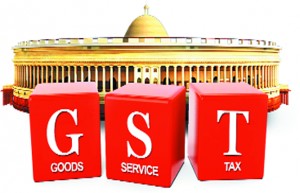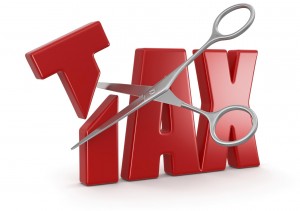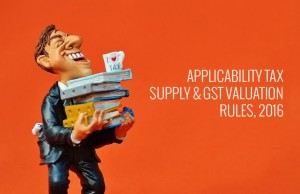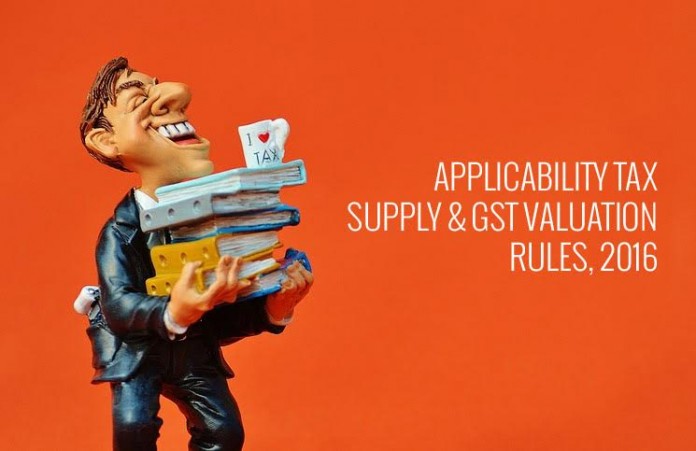In this blog post, Kaushik Neogi, a student pursuing his LL.B (4th year) from Delhi Metropolitan Education, affiliated to Guru Gobind Singh Indraprastha University and a Diploma in Entrepreneurship Administration and Business Laws from NUJS, gives a detailed analysis of the applicability of the GST Act, 2016 and the GST Valuation Rules, 2016.
Background
- The first proposition for GST was made in 2011 in the Lok Sabha through the Constitution (115th Amendment) Bill, 2011. The attempt was unsuccessful as the bill lapsed because of dissolution of the 15th Lok Sabha.
- The proposition of GST was again introduced in 2014 on the 19th of December in the Lok Sabha through the Constitution (122nd Amendment) Bill, 2014.
- Lok Sabha passed the bill on the 6th of May 2015.
- The Bill gets referred to a Select Committee of Rajya Sabha on the 14th of May 2015.
- Rajya Sabha passes the Bill with amendments on the 3rd of August 2016.
- Lok Sabha unanimously passes the Bill with the amendments as suggested by Rajya Sabha with all the 443 members of the House voting for the Bill on the 8th of August 2016.
- The government wishes to bring the provisions of the Bill to effect from the 1st of April 2017.
Introduction
The GST regime is the Indian government’s initiative to check and curtail the existing tax system of indirect taxes in India. Currently, the indirect taxes imposed in India are on goods and services, some levied by the Centre and some by the States.
The GST regime intends to classify most indirect taxes under a single taxation regime. GST is a value added tax levied on goods and services. The implementation of GST is aimed to increase tax compliance, broaden the tax base and to avoid leakages and distortions due to inter-state tax variations.[2]
The Finance Ministry in June 2016 released the Model GST Law[3] under which the following were released-
Goods and Services Tax Act, 2016, The Integrated Goods and Services Tax Act, 2016 & GST Valuation (Determination of the Value of Supply of Goods and Services) Rules, 2016.
Certain aspects of the Goods and Services Tax Act, 2016[4]
 Extent and Applicability:
Extent and Applicability:
Section 1 provides for the Short title, extent, and commencement, as per 1(2) the Act will extend to the whole of India, meaning this tax regime for Indirect taxes will be applicable in the State of Jammu and Kashmir too.
This is the first time when an indirect tax law has been uniformly made applicable to the state of Jammu and Kashmir along with the rest of India.
Important definitions under Section 2:
| Composite supply | Section 2(27) |
o two or more goods; provided in the course or furtherance of business, whether or not the same can be segregated.” |
| Continuous supply of goods | Section 2(30) |
|
| Continuous supply of services | Section 2(31) |
|
| Input service | Section 2(54) |
|
| Input | Section 2(55) |
|
| Input Service Distributor | Section 2(56) |
|
| Input tax | Section 2(57) |
|
| Output tax | Section 2(72) |
|
| services | Section 2(88) |
|
Meaning and Scope of Supply:
Section 3 of the Act provides for the meaning and scope of supply.
As per 3(1) Supply includes:
- All forms of supply of services and/or goods such as:
- barter;
- transfer;
- sale;
- license;
- exchange;
- rental;
- lease; or
- disposal
made or agreed to be made for consideration by a person in the course or furtherance of business;
- Importation of service, whether or not for a consideration and whether or not in the course or furtherance of business; and
- A supply specified in Schedule I made or agreed to be made without consideration.
| SCHEDULE I
MATTERS TO BE TREATED AS SUPPLY WITHOUT CONSIDERATION |
|
When there is Permanent disposal or transfer of business assets. |
| When the business assets are Temporarily applied for a private or non-business use. |
| When Services are put to a non-business or private use. |
| When Assets are retained after the registration. |
| When there is a supply of services and goods by one taxable person to another taxable/nontaxable person in the course or furtherance of business.
Note* supply of goods by a registered taxable person to a job-worker in terms of section 43A shall not be treated as a supply of goods. |
3(2) provides that the matters mentioned in Schedule II shall apply for determining what is, or is to be treated as a supply of goods or a supply of services.
| SCHEDULE II
MATTERS TO BE TREATED AS SUPPLY OF GOODS OR SERVICES |
|
| Transfer
|
§ transfer of goods or § of an undivided share in goods or § of right in goods
|
| Land and Building |
§ Tenancy; § easement; § lease; or § license
|
| Treatment or process | Any treatment or process which is being applied to another person’s goods is a supply of services.
|
| Transfer of business assets |
|
| The following shall be treated as “supply of service.”
|
|
| The following shall be treated as supply of goods | Supply of goods by any unincorporated association or body of persons to a member thereof for cash deferred payment or other valuable consideration. |
According to 3(2A) a person acting as an agent who, for an agreed commission or brokerage, either supplies or receives any goods and services on behalf of any principal, such transaction shall be deemed to be a supply.
3(3) provides that Subject to sub-section (2), the Central or a State Government may, upon recommendation of the Council, specify, by notification, the transactions that are to be treated as—
- a supply of goods and not as a supply of services; or
- a supply of services and not as a supply of goods; or
- neither a supply of goods nor a supply of services.
3(4)provides that not contrary to anything contained in sub-section (1), the supply of any branded service by an aggregator, as defined in section 43B, under a brand name or trade name owned by him shall be deemed to be a supply of the said service by the said aggregator.
Levy of, and Exemption from, Tax:

Section 7 of the Act provides for levy and Collection of Central/State Goods and Services Tax on all intra-State supplies of goods and services at the rate to be specified later, and 7(2) provides that every taxable person shall pay the tax as per the provisions of the Act.
7(3) provides for the provision of reverse charge on certain categories of goods and services to be specified, where the tax shall be payable by the person receiving such mentioned goods and services.
Section 8 of the Act Provides for compounded Levy. Under which the Central or State government may permit a registered taxable person whose turnover in a financial year does not exceed 50 lacs of rupees, to pay, in lieu of the tax payable by him, an amount calculated at such rate, not less than 1%, of the turnover during the year.
- Provided that no such permission shall be granted to a taxable person who effects any inter-state supplies of goods and services or to a person who is liable to pay tax under sub-section (3) of section 7 of the Act.
Section 9 of the Act defines a taxable person as a person who carries on any business at any place in India and who is registered or required to be registered under Schedule III of this Act for payment of tax.
- Agriculturist has not been regarded as a taxable person under this Act.
- A person who is required to be registered under paragraph 1 of Schedule III of this Act shall not be considered as a taxable person until his aggregate turnover in a financial year exceeds [Rs. 10 lakh]
- A a person who is required to be registered under paragraph 1 of Schedule III of this Act shall not be considered as a taxable person until his aggregate turnover in a financial year exceeds [Rs. 5 lakh], this provision is only valid when the taxable person conducts his business in any of the North-Eastern States.
| SCHEDULE III Person to be registered under paragraph 1. |
|
Every supplier is to be registered in the State from where he makes the supply of goods and services. Where the aggregate turnover in a financial year of the supplier does exceed Rs. 9 lakh. |
9(3) provides for the persons who are not to be considered as taxable persons under the act being-
- any person who provides services as an employee of his employer in the course of, or about his employment, or by any other legal ties creating the relationship of employer and employee as regards working conditions, remunerations and employer’s liability.
- any person engaged in the business of exclusively supplying goods and services that are not liable to tax under this Act.
- any person, liable to pay tax under sub-section (3) of section 7, receiving services of not exceeding a value (to be mentioned later) in a year for personal use, other than for use in the course or furtherance of his business.
Under the provisions of Section 10 if the Central or a State Government is satisfied that it is necessary for the public interest, have the power to grant exemption from tax following certain recommendations and procedures. Section 11 provides for remission of tax on supplies found deficient in quantity.
Time and Value of Supply:
Section 12 provides for time of supply of goods. The main provisions of this section are explained in the table below-
| 12(2) | The time of supply of goods shall be the earliest of |
|
| 12(3) | In case of continuous supply of goods |
|
The date of receipt of payment, whichever is earlier, shall be the time of supply. 12(5)
In case of supplies in respect of which tax is paid or liable to be paid on reverse charge basis, the time of supply shall be the earliest of:
- The date of the receipt of goods, or
- The date on which the payment is made, or
- The date of receipt of invoice, or
- The date of debit in the books of accounts.12(6)
If the goods (being sent or taken on approval or sale or return or similar terms) are removed before it is known whether supply will take place, the time of supply shall be
- At the time when it becomes known that the supply has taken place or
- Six months from the date of removal, whichever is earlier.
Section 13 provides for time of supply of services. The main provisions of this section are explained in the table below-
| 13(2) | The time of supply of services shall be |
|
| 13(3) | In case of continuous supply of services, the time of supply shall be |
|
| 13(5) | In case of supplies in respect of which tax is paid or liable to be paid on reverse charge basis, the time of supply shall be the earliest of |
|
| 13(6) |
|
|
Section 14 provides for Change in rate of tax in respect of the supply of services. The main provisions of this section are explained in the table below-
| 14(1) | Not contrary to anything contained in section 13 | The time of supply, in cases where there is a change in the effective rate of tax in respect of services, shall be determined in the following manner, namely- In case the taxable service has been provided before the change in effective rate of tax –
In case the taxable service has been provided after the change in effective rate of tax-
|
For the purpose of this section, “the date of receipt of payment” shall be the date on which the payment is entered in the books of accounts of the supplier or the date on which the payment is credited to his bank account, whichever is earlier:
Provided that the date of receipt of payment shall be the date of credit in the bank account when such credit in the bank account is after 4 working days from the date of change in the effective rate of tax.
Section 15 provides for the Value of taxable supply. Under the provisions of this Section-
| 15(1) | The value of a supply of goods and/or services shall be the transaction value that |
“Is the payable or price paid for the said supply of services and/or goods where the price is the sole consideration for the supply and the supplier, and the recipient of the supply is not related.” |
| 15(2) | The transaction value under sub-section (1) shall include | § “Any amount that the supplier is liable to pay in relation to such supply but which has been incurred by the recipient of the supply and not included in the price actually paid or payable for the goods and/or services”; § “The value, apportioned as appropriate, of such goods and/or services as are supplied directly or indirectly by the recipient of the supply free of charge or at reduced cost for use in connection with the supply of goods and/or services being valued, to the extent that such value has not been included in the price actually paid or payable”; § “Royalties and license fees related to the supply of goods and/or services being valued that the recipient of supply must pay, either directly or indirectly, as a condition of the said supply, to the extent that such royalties and fees are not included in the price paid or payable”; § “Any taxes, duties, fees and charges levied under any statute other than the SGST Act or the CGST Act or the IGST Act”; § “Incidental expenses, such as, commission and packing, charged by the supplier to the recipient of a supply, including any amount charged for anything done by the supplier in respect of the supply of goods and/or services at the time of, or before delivery of the goods or, as the case may be, supply of the services”; § “Subsidies provided in any form or manner, linked to the supply”; § “Any reimbursable expenditure or cost incurred by or on behalf of the supplier and charged in relation to the supply of goods and/or services”; § “Any discount or incentive that may be allowed after the supply has been affected: Provided that such post-supply discount which is established as per the agreement and is known at or before the time of supply and specifically linked to relevant invoices shall not be included in the transaction value.” |
| 15(3) | The transaction value under sub-section (1) shall not include | “Any discount allowed before or at the time of supply provided such discount is allowed in the course of normal trade practice and has been duly recorded in the invoice issued in respect of the supply.” |
| 15(4) | The value of the supply of goods and/or services in the following situations which cannot be valued under sub-section (1) | “Shall be determined in such manner as may be prescribed in the rules.
|
GST Valuation (Determination of the Value of Supply of Goods and Services) Rules, 2016[5]
Important definitions under Rule 2-
| goods of like kind and quality | “Means goods which are identical or similar in physical characteristics, quality and reputation as the goods being valued, and perform the same functions or are commercially interchangeable with the goods being valued and supplied by the same person or by a different person.” |
| services of like kind and quality | “Means services which are identical or similar in nature, quality and reputation as the services being valued and supplied by the same person or by a different person.” |
| transaction value | “Means the value of goods and/or services within the meaning of section 15 of the CGST Act.” |
Rule 3 Provides for methods of determination of value. Under this Rule-
- Subject to rule 7, the value of goods and/or services shall be the transaction value.
- The “transaction value” shall be the value determined in monetary terms.
- Where the supply consists of both taxable and non-taxable supply, the taxable supply shall be deemed to be for such part of the monetary consideration as is attributable to it.
- The transaction value shall be accepted even where the supplier and recipient of supply are related, provided that the relationship has not influenced the price.
- Where goods are transferred from—
- One place of business to another place of the same business
- the principal to an agent or from an agent to the principal, whether or not situated in the same State, the value of such supply shall be the transaction value.
- The value of supplies specified in sub-section (4) of section 15 of the Act shall be determined by proceeding sequentially through rules 4 to 6.
Rule 4 provides for determination of the value of supply by comparison. Under this rule-
- Where the value of a supply cannot be determined under Rule 3, the value shall be determined on the basis of the transaction value of goods and/or services of like kind and quality supplied at or about the same time to other customers, adjusted in accordance with the provisions of sub-rule mentioned below.
- In determining the value of goods and/or services under sub-rule mentioned above, the proper officer shall make such adjustments as appear to him reasonable, taking into consideration the relevant factors, including-
- the difference in the dates of supply
- the difference in commercial levels and quantity levels
- the difference in composition, quality and design between the goods and/or services being valued and the goods and/or services with which they are compared
- the difference in freight and insurance charges depending on the place of supply.
Rule 5 provides for computed value method. Under this rule-
- If the value cannot be determined under Rule 4, it shall be based on a computed value which shall include the following-
- the cost of production, manufacture or processing of the goods or, the cost of provision of the services
- charges, if any, for the design or brand
- an amount towards profit and general expenses equal to that usually reflected in the supply of goods and/or services of the same class or kind as the goods and/or services being valued which are made by other suppliers.
Rule 6 provides for the residual method. Under this rule-
- When the value of the services and/or goods is not able to be determined as per the provisions of rule 5, the value shall be determined using reasonable methods consistent with the principles and general provisions of these rules.
Rule 7 provides for rejection of declared value and Rule 8 provides for valuation in certain cases.
 Conclusion
Conclusion
The provisions discussed in this post are covering the main aspects of the model law relating to definitions, taxability, and supply. The model law apart from these subjects provides for the procedures relating to assessment, audit, registration and various other guidelines. Along with provisions relating to input credit available to the taxpayers, offenses under the Act and transitional provisions provide for a smooth and hassle free implementation of this new tax regime.
Footnotes:
[1]http://www.prsindia.org/uploads/media/Constitution%20122nd/Brief–%20GST,%202014.pdf
[2]http://finmin.nic.in/workingpaper/gst%20reforms%20and%20intergovernmental%20considerations%20in%20india.pdf
[3]http://www.cbec.gov.in/htdocs-cbec/gst
[4]http://www.cbec.gov.in/resources//htdocs-cbec/deptt_offcr/model-gst-law.pdf
[5]http://www.cbec.gov.in/resources//htdocs-cbec/deptt_offcr/model-gst-law.pdf
 Serato DJ Crack 2025Serato DJ PRO Crack
Serato DJ Crack 2025Serato DJ PRO Crack









 Allow notifications
Allow notifications



